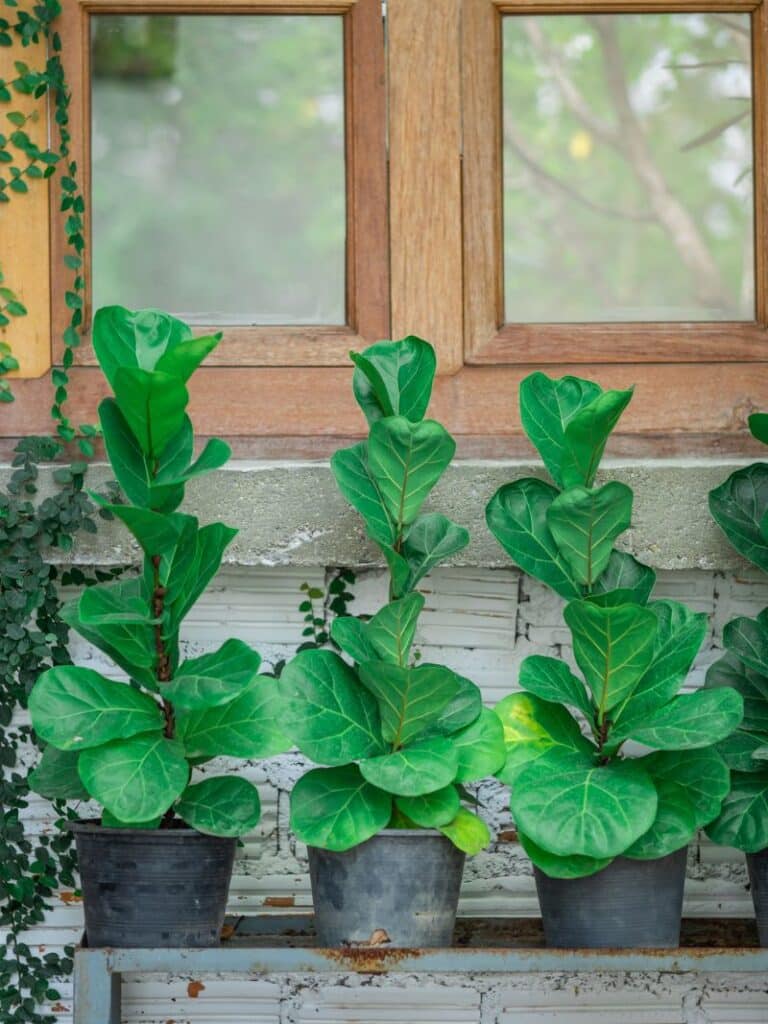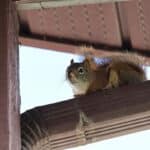Taking the spotlight of a drama queen, fiddle-leaf figs are definitely a showoff in the world of houseplants. They turn any boring space into a focal point of a room and act as if they are about to give a pithy statement. Thanks to their heavily-veined and classic violin-shaped leaves that grow upright from a pole-like branch.
Knowing the Fiddle-leaf Figs
Fiddle-leaf figs are native to Africa where they grow in warm and wet conditions of the tropical rainforests. They can reach a height of up to 50 feet tall in their natural habitat while only reaching about 10 feet when grown indoors. Leaves do not shed and are all green the whole year.
The figs are members of the Moraceae or the Mulberry family together with over a thousand other plant species. The famous cultivars of Ficus lyrata that are available in most garden stores are the following:
- Ficus lyrata ‘Compacta’ – similar to the height of the main species but the leaves are smaller and more compact
- Ficus lyrata ‘Bambino’ – a cultivated variety that is a miniature version of the main species; grows only a few feet tall
- Ficus lyrata ‘Variegata’ – a rare cultivated variety that displays a variegated or a mix of green and whitish foliage
Why Soil Matters for Fiddle-leaf Figs?
All plants found on the planet, technically the terrestrials, need the soil to live. The Ficus lyrata is totally not an exception. They think of the soil as a reservoir where their root ball can get nutrients and water at any moment they need. They also need the soil for support to stand still similar to a foundation that firmly anchors a tall building.
When plants are taken from their natural soil for reasons of growing fiddle leaf figs indoors, they are deprived of some basic needs. The only way to successfully cultivate them is by providing an alternative soil where they can have the essential nutrition, water, and anchorage.
Potting soil is the term used to call the growing medium of plants cultivated in containers or pots. It may or may not contain actual soil.
A potting soil that does not contain an actual soil is referred to as potting mix. Potting mix is used widely for many indoor plants because it is 100% free of unwanted plant seeds.
The Best Potting Soil for Fiddle-Leaf Figs
Although fiddle-leaf figs are hardy and will tend to grow in almost any type of soil, the best potting soil for them is the one that almost replicates their native habitat. The forest floors wherein they are naturally found are heavily mulched with all kinds of forest debris at all stages of decomposition.
In short, the fiddle leaf fig soil needs to be rich in organic matter, holds a considerable amount of water, and drains well.
Organic matter (OM) is formed from the decomposition of the remains of living organisms and their parts including feces. The OM returns the nutrients that make up the body of a plant or animal back to the soil mix.
The forest floor is densely covered with leaf litter, old stems and tree trunks, and dead plants and animals that will all get broken down and recycled by nature itself. This dense layer of organic matter helps prevent erosion and improves the structure of what can otherwise be dense soil.
The thick forest mulch consists of organic materials in various sizes and textures. Chunky materials like shed bark and stem trimmings enhance soil volume and facilitate water movement.
When it rains, this chunky mulch absorbs water, retaining it for longer periods. The roots of the fiddle leaf fig trees can access this moisture as needed, promoting healthy growth while avoiding issues like root rot.
How to Make the Best Potting Soil for Fiddle-leaf Figs?
There’s a lot of available pre-made mix that you can buy in local garden stores. But knowing what kind and how to create your potting mix is quite a skill among plant hobbyists and gardeners. We do not know but maybe one day it can get you a job or start a business if you are really good at it!
The Fiddle-leaf fig tree needs a balance of moisture-retentive and well-draining soil that is high in organic matter. The soil pH level should be slightly acidic between 5.5 – 6.5.
Ingredients of a FIddle-leaf Fig Potting Soil
To make the best potting soil, you will need the following:
- Peat moss or coco peat – It is an organic material that is commonly used as a base for most potting soil and seed starting mediums. It can absorb moisture many times its weight and releases it for plant uptake. It also stores nutrients in the potting mix. The only difference between peat moss and coco peat is that the latter offers a more eco-friendly way of harvesting than the former.
- Perlite – It is a mineral that is excellent in creating a free-draining potting mix for plants. It is white and very lightweight, similar to styrofoam. The process of creating perlite is similar to cooking popcorn. It is made from volcanic glass that is heated to pop and expands multiple times its size.
- Compost – It is a mixture of decomposed organic materials such as peat, shed barks, leaf trimmings, and small twigs. It is very rich in organic matter. Over time it can prevent compaction and improve drainage of the mix.
Recipe for making a Fiddle-leaf Fig Potting Soil
Look for a big container or use a wheelbarrow to mix all the ingredients. The ratio should be 2 parts peat moss or coco peat, 1 part perlite, and 1 part compost.
Add water to moisten the soil so you can mix it thoroughly but make sure that it will not become too wet. Wear a mask because perlite has fine dust that can wound the lungs if inhaled.
Guide in Buying Fiddle-leaf Fig Potting Mix
The components and ratio of a potting mix differ from one brand to another. When you want to purchase a pre-made mix for fiddle-leaf figs, look for a well-draining one. This helps prevent brown spots on fiddle leaf fig and other problems later.
However, avoid buying a mix made specifically for cactus and succulents that contain a lot of sand. Such mixes dry easily and provide poor anchorage unless you add a subsequent amount of peat moss or coco coir.
How and When to Repot Fiddle-leaf Figs?
The Ficus lyrata can be repotted once every two years. The best time to do this is during spring when the weather conditions can be helpful for the tree to recover quickly from root shock. Below is a step-by-step process for repotting a fiddle-leaf fig:
- A day or two before repotting, give your Ficus a thorough drink of water. This will prepare the fiddle leaf fig plant and will lessen the risk of damaging the roots.
- Choose the right container size. Height is one asset a fiddle-leaf fig offers as a houseplant. As a general guide, follow the rule of thirds wherein the pot or container should be at least ⅓ of the height of the tree.
- Put drainage holes at the bottom of your new pot. Excess water will drain from these holes to prevent waterlogging.
- Carefully pull your Ficus plant out from its old container. You can use an old knife or spatula to scrape the inner surface of the pot to ease the process.
- Inspect the roots and remove any black or dead roots. Use clean sharp scissors to make smooth cuts.
- If you think the old soil of your tree has gone bad, remove it and do not leave traces as much as possible. Be extra careful not to damage the roots.
- Fill the new pot with fresh potting soil at least ⅓ of its height or depending on the height of your Fiddle-leaf fig.
- Put the plant inside the container and fill the remaining gaps with the potting soil. You can gently apply pressure to level off the soil.
- Water the plant thoroughly. The first drink must be plenty enough to fill all the gaps and settle the attachment of the roots to the soil. Add more potting soil if it has sunk.
- Tie the plant to a stake or pole to provide physical support. Wait for a few weeks up to a month for new growth. Do not fertilize yet to prevent the burning of the newly formed roots.
FAQs
Can I use fiddle leaf fig soil for other plants?
Fiddle leaf fig soil can be suitable for other plants that prefer well-draining soil with good aeration, although it may not be optimal for all species. It typically consists of a blend of peat moss, perlite, and pine bark, which can work well for various indoor tropical plants.
Do fiddle leaf figs like acidic or alkaline soil?
The healthy fiddle leaf fig plants generally prefer slightly acidic to neutral soil with a pH range between 6.0 to 7.0. It’s important to avoid highly alkaline soil as it can hinder nutrient absorption and lead to yellowing of leaves or nutrient deficiencies.
What soil for potted ficus?
Potted ficus plants, including fiddle leaf figs, thrive in well-draining potting mixtures that provide good aeration for their roots. A blend of peat moss, perlite, and compost or pine bark can create an ideal growing medium for potted ficus, ensuring sufficient drainage and nutrient availability.
We hope this guide provides you all the information you need when it comes to the best soil for fiddle leaf fig.
*image by Cavan/depositphotos







